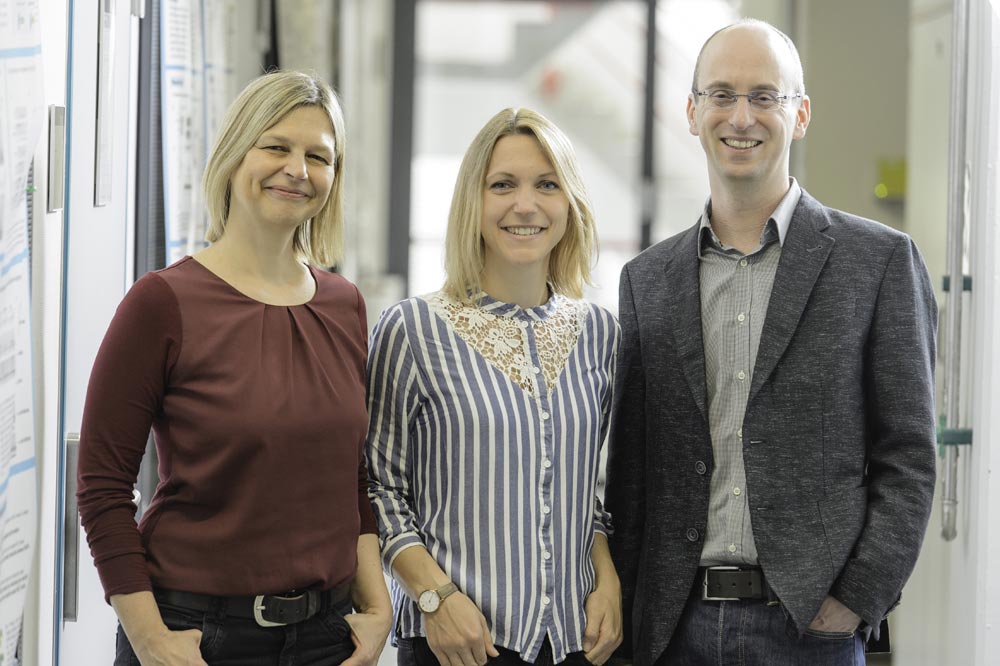
Researchers Reveal Hidden Protein Structures Using IR Spectroscopy

From left to right: Professor Karin Hauser, Annika Krüger und PD Dr Aswin Mangerich
Copyright: Jespah Holthof, University of Konstanz
Using infrared (IR) spectrosocopy, researchers at the University of Konstanz were able to uncover the interaction between the p53 protein, a tumour suppressor that controls the cell cycle, and poly(ADP-ribose) (PAR) and deoxyribonucleic acid (DNA) at the molecular level.
The nucleic acid-like biopolymer PAR serves as a cellular signal transmitter and helps to regulate protein activity.
By studying the interaction between p53 and PAR, the researchers were able to learn more about molecular reactions to cellular stress in response to, for example, DNA damage, which represents a potential tumour risk.
Their basic research on the processes behind DNA damage is, on the one hand, paramount to understanding how cancer develops and how cells age.
On the other hand, the innovative scientific approach is advancing the research carried out in their field. Their research results were published in issue 9 (21 May 2019) of the scientific journal Nucleic Acids Research by the Oxford University Press.
In a new article published on “campus.kn”, the online magazine of the University of Konstanz, we tell the story of the project’s development, which builds on interdisciplinary linkages especially between early career researchers: https://www.campus.uni-konstanz.de/en/science/uncovering-hidden-protein-structur…
Key facts:
• Article on “campus.kn”, the online magazine of the University of Konstanz, about a novel spectroscopic approach to uncover protein structures that originates from interdisciplinary collaboration at the University of Konstanz
• Original publication: Annika Krüger, Anna Stier, Arthur Fischbach, Alexander Bürkle, Karin Hauser, Aswin Mangerich, Interactions of p53 with poly(ADP-ribose) and DNA induce distinct changes in protein structure as revealed by ATR-FTIR spectroscopy, Nucleic Acids Research, 2019, 47:9, 4843–4858 (https://doi.org/10.1093/nar/gkz175)
• Investigation of interaction between the p53 protein and poly(ADP-ribose) (PAR) and deoxyribonucleic acid (DNA)
• The basic research on the processes behind DNA damage is paramount to understanding how cancer develops and how cells age
Note to editors:
You can download a photo here:
https://cms.uni-konstanz.de/fileadmin/pi/fileserver/2019/Bilder/verborgene_prote…
Caption: From left to right: Professor Karin Hauser, Annika Krüger und PD Dr Aswin Mangerich
Copyright: Jespah Holthof, University of Konstanz
Contact
University of Konstanz
Communications and Marketing
Phone: + 49 7531 88-3603
E-Mail: kum@uni-konstanz.de
– uni.kn
Annika Krüger, Anna Stier, Arthur Fischbach, Alexander Bürkle, Karin Hauser, Aswin Mangerich, Interactions of p53 with poly(ADP-ribose) and DNA induce distinct changes in protein structure as revealed by ATR-FTIR spectroscopy, Nucleic Acids Research, 2019, 47:9, 4843–4858 (https://doi.org/10.1093/nar/gkz175)












